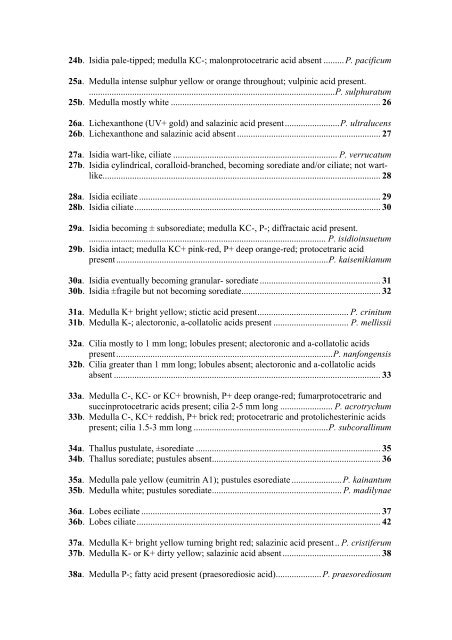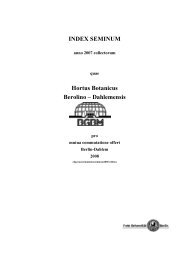Keys to the macrolichens and checklist of the lichens and ...
Keys to the macrolichens and checklist of the lichens and ...
Keys to the macrolichens and checklist of the lichens and ...
You also want an ePaper? Increase the reach of your titles
YUMPU automatically turns print PDFs into web optimized ePapers that Google loves.
24b. Isidia pale-tipped; medulla KC-; malonpro<strong>to</strong>cetraric acid absent ......... P. pacificum<br />
25a. Medulla intense sulphur yellow or orange throughout; vulpinic acid present.<br />
............................................................................................................P. sulphuratum<br />
25b. Medulla mostly white ............................................................................................ 26<br />
26a. Lichexanthone (UV+ gold) <strong>and</strong> salazinic acid present........................P. ultralucens<br />
26b. Lichexanthone <strong>and</strong> salazinic acid absent ............................................................... 27<br />
27a. Isidia wart-like, ciliate ........................................................................ P. verrucatum<br />
27b. Isidia cylindrical, coralloid-branched, becoming sorediate <strong>and</strong>/or ciliate; not wartlike..........................................................................................................................<br />
28<br />
28a. Isidia eciliate .......................................................................................................... 29<br />
28b. Isidia ciliate............................................................................................................ 30<br />
29a. Isidia becoming ± subsorediate; medulla KC-, P-; diffractaic acid present.<br />
........................................................................................................ P. isidioinsuetum<br />
29b. Isidia intact; medulla KC+ pink-red, P+ deep orange-red; pro<strong>to</strong>cetraric acid<br />
present.............................................................................................P. kaisenikianum<br />
30a. Isidia eventually becoming granular- sorediate ..................................................... 31<br />
30b. Isidia ±fragile but not becoming sorediate............................................................. 32<br />
31a. Medulla K+ bright yellow; stictic acid present........................................ P. crinitum<br />
31b. Medulla K-; alec<strong>to</strong>ronic, a-colla<strong>to</strong>lic acids present ................................. P. mellissii<br />
32a. Cilia mostly <strong>to</strong> 1 mm long; lobules present; alec<strong>to</strong>ronic <strong>and</strong> a-colla<strong>to</strong>lic acids<br />
present...............................................................................................P. nanfongensis<br />
32b. Cilia greater than 1 mm long; lobules absent; alec<strong>to</strong>ronic <strong>and</strong> a-colla<strong>to</strong>lic acids<br />
absent ..................................................................................................................... 33<br />
33a. Medulla C-, KC- or KC+ brownish, P+ deep orange-red; fumarpro<strong>to</strong>cetraric <strong>and</strong><br />
succinpro<strong>to</strong>cetraric acids present; cilia 2-5 mm long ....................... P. acrotrychum<br />
33b. Medulla C-, KC+ reddish, P+ brick red; pro<strong>to</strong>cetraric <strong>and</strong> pro<strong>to</strong>lichesterinic acids<br />
present; cilia 1.5-3 mm long ...........................................................P. subcorallinum<br />
34a. Thallus pustulate, ±sorediate ................................................................................. 35<br />
34b. Thallus sorediate; pustules absent.......................................................................... 36<br />
35a. Medulla pale yellow (eumitrin A1); pustules esorediate ......................P. kainantum<br />
35b. Medulla white; pustules sorediate......................................................... P. madilynae<br />
36a. Lobes eciliate ......................................................................................................... 37<br />
36b. Lobes ciliate........................................................................................................... 42<br />
37a. Medulla K+ bright yellow turning bright red; salazinic acid present .. P. cristiferum<br />
37b. Medulla K- or K+ dirty yellow; salazinic acid absent ........................................... 38<br />
38a. Medulla P-; fatty acid present (praesorediosic acid).................... P. praesorediosum




